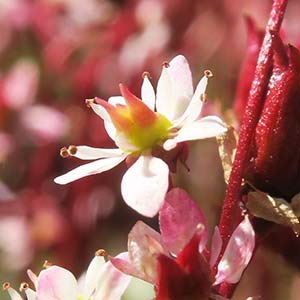Micranthes lyallii
Micranthes oregana
Lyall's saxifrage, red-stemmed saxifrage
bog saxifrage, Oregon saxifrage
Leaves all basal, the leaves wedge-shaped to fan-shaped, 10-25 mm. long and nearly as broad, coarsely dentate with 7-9 teeth, with slender petioles of similar length, glabrous or with a few soft, brown hairs.
Leaves basal, 10-20 cm. long, contracted to a broadly-winged petiole, the blades elliptic-oblanceolate to ovate-lanceolate, entire or shallowly toothed, nearly glabrous, but with soft hairs on the petiole margins.
Inflorescence, calyx and fruits often bright red; inflorescence a cyme with up to 15 flowers, the peduncles slender, often with linear, entire bracts;
calyx lobed almost to the base, the 5 lobes oblong-lanceolate, 2-3 mm. long, sharply reflexed;
petals 5, white, aging to pink, 2.5-4 mm. long, the blade oblong-oval, rounded to a short, broad claw;
stamens 10, equaling the petals, the filaments white, club-shaped;
carpels often 3-5, fused only 0.5-1 mm., the ovary mostly superior, the carpels tapered to styles less than 1 mm. long.
Inflorescence an elongate panicle, narrow to somewhat diffuse;
calyx 2-3.5 mm. long, the 5 reflexed lobes oblong lanceolate;
petals white to greenish-white, usually 5 but sometimes 1 or more lacking, often unequal in size, obovate to ovate-oblong, 2-4 mm. long and 1-2.5 broad;
stamens 10, filaments broadly club-shaped, 1-2 mm. long, greenish-white to pinkish.
Follicle 7-12 mm. long exclusive of the slender, divergent, stylar beaks.
Ovary nearly superior in fruit;
carpels 2-4.
Micranthes lyallii
Micranthes oregana
- Local floras:
CA,
OR,
WA
- Local Web sites:
CalFlora,
CalPhotos,
Flora NW,
PNW Herbaria
WildflowerSearch
iNaturalist (observations)
USDA Plants Database
- LBJ Wildflower Center
- SEINet
- Plants of the World Online
- Encyclopedia of Life
- Wikipedia
- Google Image Search



